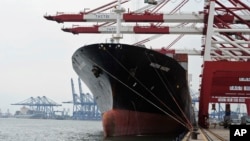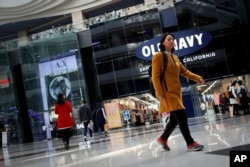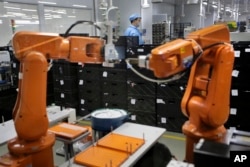A United Nations economic and social report released Monday warns Asia’s positive economic outlook “faces significant risk” from rising trade protectionism, especially concerns over U.S. trade policy with key partners such as China.
The U.N.’s Economic and Social Commission for Asia and the Pacific (UNESCAP) survey is largely positive for the region, which now accounts for some 30 percent of total global output. If sustained, the survey said this could reach 50 percent by 2050.
For more than 70 years, Asia’s export-led growth has helped lift millions out of poverty with such target markets as the U.S. and Europe.
But in more recent years the economies have come to rely more on domestic demand given the “prolonged weakness in external demand and global trade,” the survey said.
Regional growth is forecast by the U.N. economists at close to 5 percent, with China — a cornerstone of the region’s economies — expanding at 6.5 percent in 2017, and India growing by 7.1 percent.
China’s economic conditions are seen as ‘stable’ with rebalancing, restructuring and deleveraging [debt] leading to “new normal growth trends.” Russia, buoyed by higher oil prices, is also forecast to show positive growth in 2017.
But the general positive outlook is being overshadowed by concerns of trade protectionism impacting employment and economic growth.
“The most significant risk to the broadly positive economic outlook is rising trade protectionism,” the survey said.
It noted recent shifts in U.S. policies concerning trade, currency and immigration along with negotiations over Britain’s exit from the European Union, “have increased global policy uncertainty and could have negative impacts on the region, including for China’s goods exports and India’s services exports.”
US new stance
U.S. President Donald Trump adopted an aggressive stance over China’s trade and currency policies ahead of the U.S. presidential election. But Trump has recently toned down his comments as Washington has looked to Beijing to back measures to curb North Korea’s development of nuclear weapons.
Shamshad Akhtar, UNESCAP executive secretary, said the debate over protectionism and “distrust of globalization” needs to be addressed.
“The region now accounts for nearly one-third of the world output. Yet there is growing distrust of globalization and emerging protectionist tendencies that have created global uncertainty,” she said.
“If not addressed, [it] has implications for growth prospects in [the] Asia and Pacific region that has traditionally been dependent on its exports for jobs and prosperity,” Akhtar said.
The UNESCAP said growing global trade has led to wide-ranging regional economic benefits over decades. But the debate is being challenged by opposition to globalization, especially in the U.S. and Europe.
But Akhtar said it was difficult to “arrest globalization because of labor mobility, capital mobility and so on, [that] have been instituted now for years”.
“So I want to be rightly understood that distrust [of globalization] is really [a] public and politicians’ gimmick more than anything else — but of course we have to take appropriate policies,” she said.
The U.N. survey said projections show if trade protectionism and global uncertainty increase, growth for major developing countries could be lower by up to 1.2 percentage points.
The survey noted while the Asia Pacific region remains “the engine of global growth,” expansion was insufficient in the face of several challenges.
The commission pointed to rising income inequalities, with the expansion of decent employment also a challenge.
The region was also “falling behind the rest of the world in terms of social protection, financing and coverage” in contrast to levels of spending in developed economies.
Environment
Environmental damage was a key concern in the face of rapid economic expansion over several decades, with growth coming at a steep environmental cost.
“On average developing Asia–Pacific economies use twice as many resources per dollar of GDP as the rest of the world. Environmental degradation and carbon emissions not captured in GDP [growth data] undermine the sustainability of economies,” the survey said.
The survey called for improved governance and accountability, seen as a measure for improved economic outcomes.
Countries, it said, that perform better on governance measures, focusing on the rule of law, regulations and control corruption and government effectiveness also “tend to mobilize and spend their fiscal resources efficiently and effectively.”














